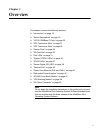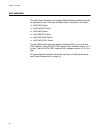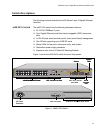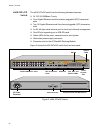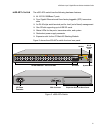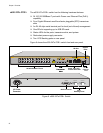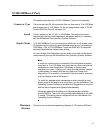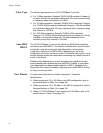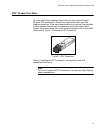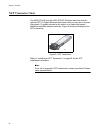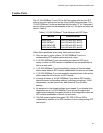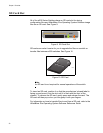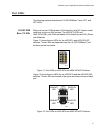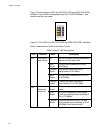
x600 Series Layer 3 Gigabit Ethernet Switches Installation Guide
25
10/100/1000Base-T Ports
This section describes the 10/100/1000Base-T ports on the switches.
Connector Type The ports are 8-pin RJ-45 connectors that use four pins at 10 or 100 Mbps
and all eight pins at 1000 Mbps. For the pin assignments, refer to “RJ-45
Twisted Pair Port Pinouts” on page 106.
Speed A port’s speed can be 10, 100, or 1000 Mbps. The speed can be set
automatically through Auto-Negotiation, the default setting, or manually
with the AlliedWare Plus
Operating System Software.
Duplex Mode A 10/100/1000Base-T port can operate in either half- or full-duplex mode.
(Full-duplex mode is the only mode available when a port is operating at
1000 Mbps.) The 10/100/1000Base-T ports are IEEE 802.3u-compliant
and Auto-Negotiate the duplex mode setting.
You can disable Auto-Negotiation on the switch ports and set the duplex
mode manually through the AlliedWare Plus
Operating System Software.
Note
In order for a switch port to successfully Auto-Negotiate its duplex
mode with a 10 or 100 Mbps end node, the end node must also be
configured for Auto-Negotiation. Otherwise, a duplex mode
mismatch can occur. A switch port using Auto-Negotiation defaults
to half-duplex if it detects that the end node is not using Auto-
Negotiation. This results in a mismatch if the end node is operating
at a fixed duplex mode of full-duplex.
To avoid this problem when connecting an end node with a fixed
duplex mode of full-duplex to a switch port, use the AlliedWare Plus
Operating System Software to disable Auto-Negotiation on the port
and set the port speed and duplex mode manually.
Please be aware that disabling Auto-Negotiation also disables
Auto-MDI/MDIX. The port’s wiring configuration defaults to the MDI-
X setting. This setting can be configured with the AlliedWare Plus
Operating System Software.
Maximum
Distance
The ports have a maximum operating distance of 100 meters (328 feet).



